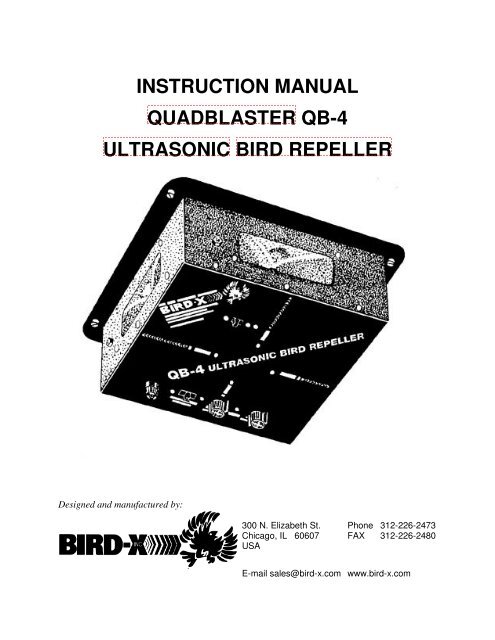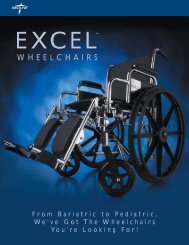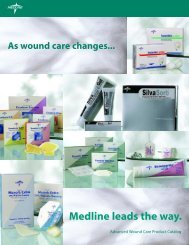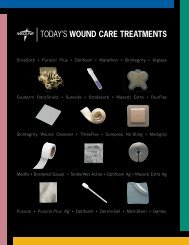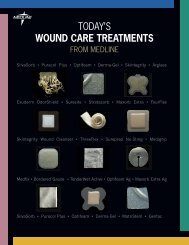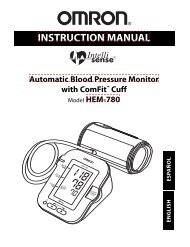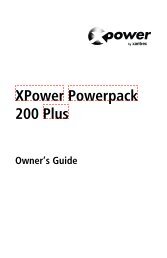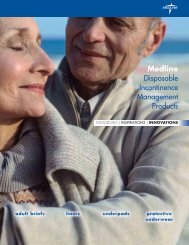instruction manual quadblaster qb-4 ultrasonic bird repeller
instruction manual quadblaster qb-4 ultrasonic bird repeller
instruction manual quadblaster qb-4 ultrasonic bird repeller
- No tags were found...
Create successful ePaper yourself
Turn your PDF publications into a flip-book with our unique Google optimized e-Paper software.
INSTRUCTION MANUALQUADBLASTER QB-4ULTRASONIC BIRD REPELLERDesigned and manufactured by:300 N. Elizabeth St.Chicago, IL 60607USAPhoneFAX312-226-2473312-226-2480E-mail sales@<strong>bird</strong>-x.com www.<strong>bird</strong>-x.com
TABLE OF CONTENTSI. Introduction..............................................................................................................3II.III.Why Control Birds?..................................................................................................3Bird Management Program......................................................................................4IV. QB-4 Ultrasonic Bird Repeller.................................................................................5A. Brief Description of Unit and How It WorksB. SpecificationsC. ControlsV. Sound Distribution Pattern.......................................................................................7VI. Mounting Instructions...............................................................................................8VII. Applications.............................................................................................................8VIII. Use of Variable Features.........................................................................................9IX. Trouble Shooting...................................................................................................10X. Precautions............................................................................................................11A. Hearing ProtectionB. ElectricalXI. Warranty and Guarantee.......................................................................................11XII. Synergy and Other Products.................................................................................11* see back cover "Addendum for Use Against Rodents"
I. INTRODUCTIONBird-X, Inc., the world's leading <strong>bird</strong> control specialists and suppliers of unique, effective andecologically safe <strong>bird</strong> repelling products, is proud to announce "The Next Generation" in <strong>bird</strong>control. We have successfully utilized the latest in Space Age Technology and electronics todevelop the all new QB-4 Ultrasonic Bird Repeller.Bird-X, Inc. has been recognized worldwide as the <strong>bird</strong> control experts for more than 30 years.Bird-X, Inc. is the only company anywhere that sells a complete line of <strong>bird</strong> repelling products(currently 15), including a variety of <strong>ultrasonic</strong> and sonic machines, visual repelling devices,non- toxic chemical roosting inhibitors, iridescent diffraction foil, netting and metal spike strips.New products are continuously being developed.Bird-X, Inc. specialists have become experts through extensive experience and research. As aresult, sales consultants are able to analyze problems and make recommendations based on eachcustomer's specific situation and needs. In addition, Bird-X, Inc. maintains and avails tocustomers a library of application case histories and other reference materials.II.WHY CONTROL BIRDS?A. Bird droppings are unsightly and cause dangerous, slippery working conditions.B. Bird droppings are unhealthy - even potentially fatal. At least sixty transmissiblediseases have been associated with <strong>bird</strong>s and their excrement.C. Bird droppings cost money. Time and materials for "cleaning up" represent costsunrecoverable by revenues.D. Birds are destructive. They deface floors, walls and equipment. They haltoperations and make repairs necessary by entangling themselves in machinery ordowning power lines. They spoil inventory by eating spillage, contaminatingpallets of food, drugs or chemicals, or by bombarding aircraft and other durablegoods with uric acidic excrement. They nibble at, or even tear out insulation.E. USDA, OSHA, local health boards and other governmental organizations can citecompanies for <strong>bird</strong> mess problems. If the problems are not corrected, companiescan be fined or shut down.
III.BIRD MANAGEMENT PROGRAMNo two <strong>bird</strong> infestation problems are exactly the same. Treat yours as you would any wellengineered project, and begin with research. Success depends on timing, organization anddiversity.Collect information related to the <strong>bird</strong> problem:A. Survey the <strong>bird</strong>s and their habits. Gather specific data as to the type andpopulation of <strong>bird</strong>s, flight and time patterns, entries and exits, and nesting, feedingand roosting habits.B. Inspect your property. Discover what the <strong>bird</strong>s find attractive about your area,and if the same conditions prevail in neighboring properties.C. Remove all inducements. Before installing the QB-4, make sure to clean thearea of all evidence of <strong>bird</strong>s: nests, fledglings, droppings, dead <strong>bird</strong>s, and theresidual scent. Because <strong>bird</strong>s and their droppings can carry many diseases, useextreme caution when removing them. Do not breathe or come into direct contactwith them. If you have questions about how to do this safely, consult an expert.(Adult <strong>bird</strong>s are likely to return to their young in order to protect them or to assistthem in leaving the area.) Remove food spillage, garbage, nesting material andother items that may be appealing to <strong>bird</strong>s.D. Maintain a clean and changing environment. For maximum effectiveness,periodically clean the area of nests and droppings, relocate or reposition the QB-4, vary the output, or turn off the unit for a short time.E. Install early. It is always best to install the QB-4 before "<strong>bird</strong> season" begins, asit is easier to keep the <strong>bird</strong>s away than to rout them out once they have alreadyestablished a living pattern.F. Use products synergistically. Two or more different kinds of devices (the QB-4plus a visual scare product and/or a roost inhibiting device) will produce asynergistic effect -- i.e., in combination, the products will yield much greatereffectiveness than the QB-4 alone. Contact Bird-X, Inc. at (312) 226-2473(BAN BIRD) for information on "companion" products.G. Consider alternate locations. Make educated guesses as to where the <strong>bird</strong>s willgo when they are repelled from their current infestation area. It may be very easyfor <strong>bird</strong>s to relocate to the other side of a warehouse, or to an adjacent loadingdock. Units should be purchased to cover these alternate areas as well.H. Note the legal and public relations environment. Find out about relatedenvironmental laws in your area.
IV.QB-4 ULTRASONIC BIRD REPELLERA. BRIEF DESCRIPTION OF UNIT AND HOW IT WORKSThe QB-4 is a sophisticated <strong>ultrasonic</strong> sound generator that is equipped with severalfeatures to enhance its effectiveness and its ability to provide both immediate andlong term <strong>bird</strong> control.The QB-4 is an electronic oscillator tuned to oscillate between 22 and 30 kHz. It ispowered by alternating current between 110 and 120 volts. (A special export model,QB-4/220, is available for use with voltages between 220 and 250 volts.) It producesan intense <strong>ultrasonic</strong> sound measured at approximately 112 dB at 1 meter at 22 kHz.The QB-4 is designed to do a twofold job:1. Rout <strong>bird</strong>s from firmly established Spatial Infestations byassailing them with an intolerable sound (see Diagram IV-a); and once out,2. Keep <strong>bird</strong>s out by forming a Perimeter Defense throughwhich the <strong>bird</strong>s will not want to re-enter the premises (see Diagram IV-b).Diagram IV-a: Spatial Infestations -illustrates a solution for a widespread <strong>bird</strong> problem.The atmosphere is totally saturated by theuse of multiple units. The sound waves overlapand cover the whole area.Diagram IV-b: Perimeter Defense -demonstrates the placement of the units once the<strong>bird</strong> problem is under control. The PerimeterDefense discourages <strong>bird</strong>s from returning.NOTE:The QB-4 was designed to be used only in an enclosed area or a semi-enclosed area.Because outdoor areas do not have the benefit of confining surfaces, <strong>ultrasonic</strong> soundwaves dissipate rapidly and lose most of their effectiveness.
B. SPECIFICATIONSPower Requirement: 115 vAC/60 hz or230 vAC/50 hzPower Consumption: 3 Watts (Steady Mode)Fuse: 1 Amp Fast Blow, .250 x 1.250", Agc 1Sound Pressure Level: 112 dB @ 1 meter @ 22 kHz(each speaker)Diagram IV-c: QB-4 Control PanelC. CONTROLS (see Diagram IV-c)1. Power Switch: Turns unit ON and OFF2. Speaker Lights: Indicate rotation rate.3. Speaker Rotation Knob: Adjusts rotation rate from slow to fast (10 to 110 rpm).
4. Frequency Switch: Has three positions -- Varied, Alternate and Steady.Varied - Modulates frequency up and down at arate controlled by the warble rate knob. During eachcycle, the frequency modulates between 22 kHz and 30kHz with peak sound pressure levels occurring at 22kHz.Alternate - Alternates output between varied modeand steady mode, each mode lasting for 12 seconds.Steady - Fixes sound output at a constant 22 kHz.5. Warble Rate Knob: Adjusts warble rate from slow (40 cycles per minute) tofast (85 cycles per minute). Inoperative when the modeswitch is set to "steady."6. Warble Light: Flashes on and off to indicate warble rate when invaried mode and stays on to indicate steady mode.7. 1 Amp Fuse: Contains a 1 Amp post-type fuse.V. SOUND DISTRIBUTION PATTERNThe QB-4 provides coverage throughout a circular area with an approximate radius of 45 feet(see Diagram V-a). Each QB-4 is capable of covering from 3,000 to 6,500 square feet,depending on the nature of the building's construction and contents (see Diagram V-c for squarefoot coverage per sound dispersing unit). Total spatial coverage is dependent on environmentalsurroundings: type of building construction; storage contents; physical layout, etc. Total spatialcoverage should exceed 6,500 square feet prime coverage plus an additional secondary coveragedependent on the surroundings. Each of the four speakers creates a dispersion pattern of 2:1(wide to high, see Diagram V-b).Diagram V-a: Effective RangeDiagram V-b: Dispersion PatternNOTE:When using multiple QB-4 units, they should be placed no more than 90 feet apart(based on a 45-foot radius).
BASIC CONSTRUCTIONSteel orother metalConcrete orMasonryWoodPRINCIPALCONTENTSMetal or other 6,500 5,250 4,500hard objectsWood or othersemi-hardobjects5,500 4,750 4,000Cloth grain or 4,500 3,750 3,000otherabsorptiveobjects(Figures are in square feet.)Diagram V-c: Basic Construction ChartVI.MOUNTING INSTRUCTIONSThere is no top or bottom to the unit, so it can be mounted in any direction -- on any plane --with screws, nails, wires or adhesives.Diagram VI-a: Mounting AlternativesVII.APPLICATIONSThe QB-4 is designed to act as an important aid in routing <strong>bird</strong>s from their infestations in plants,warehouses and semi-enclosed locations such as loading docks, railroad sidings, tunnels, breezeways,underpasses and storage sheds. Other locations include: hangars, silos, barns, stadiums,arenas, boat houses and bell towers. See Diagrams VII-a, VII-b and VII-c (on page 9) forexamples of typical installations.
Diagram VII-a: Warehouse InteriorDiagram VII-b (above): Loading DockDiagram VII-c (below): Gabled Roof/CeilingVIII.USE OF VARIABLE FEATURESEvery <strong>bird</strong> infestation presents a unique challenge. No two problems are identical, as numerousvariables affect each one. Besides the obvious differences (such as type of <strong>bird</strong>, size ofinfestation, type of structure and physical location), there are many additional environmentalfactors that make it impossible to state rigid rules for the optimum utilization of the variablefeatures of the QB-4. The following are suggestions to help maximize the effectiveness of theunit, but experimentation is often required to find the ultimate solution.The use of the variables: Frequency Mode Selection, Speaker Rotation Speed, and WarbleRate create changing environments to repel roosting <strong>bird</strong>s. Change is one of the best tools in therepelling of <strong>bird</strong>s, as <strong>bird</strong>s are creatures of habit and they do not grow accustomed to a dynamicenvironment.
For general, spatial coverage (where the infestation is fairly evenly spread out, neitherconcentrated nor isolated) a cacophony of sound should be created, using as much variation aspossible:Example: Set -- 1. FREQUENCY at Varied orAlternating;2. WARBLE RATE at Medium; and3. SPEAKER ROTATION at Slow.A fourth variable is also available when two or more units are deployed. Simply stated, avariation in the dispersed sound is achieved when the units are mounted and directed somewhatoffset from each other (rather than aligned, rank-and-file style). Think of each unit as beingmounted on a universal joint; then merely "point" each in a slightly different direction. You willhave created a fuller (i.e., not collinear) coverage.For concentrated or isolated infestations the direction of the attack should be pinpointed. Use asmuch power and "monotony" as possible:Example: Set -- 1. FREQUENCY at Steady (which delivers aconstant 22 kHz tone and eliminates "warble" altogether); and2. SPEAKER ROTATION at Fast.If multiple units are used, they should be aligned and concentrated along the same axis if andwhen possible.For all infestations that lie between the two extremes described above, the best suggestion is tointerpolate, using all three (3) variable options on the Control Panel.IX.TROUBLE SHOOTINGA. Check that the power switch of the unit is on. When the unit is on andfunctioning the speaker light will flash on when the respective speaker is on.B. Housekeeping is very important! As mentioned in the Bird ManagementProgram, the problem area should be cleaned of all evidence of <strong>bird</strong>s. Nest,fledglings, droppings, dead <strong>bird</strong>s, and the residual scent should all be removed.Check the area for unusual incentives. Remove food spillage, garbage, nestingmaterials and other items that may be appealing to <strong>bird</strong>s.C. Check the settings on the unit. Change them on a weekly basis until a suitablerange is found, and then change the settings, within that range, on a monthly basis.
X. PRECAUTIONSA. HEARING PROTECTIONEven though 22-30 kHz is above human hearing range (which averages, at top level,about 16 kHz), the intensity of 112 dB is great enough to present a chance of damageto the ear if it is directly exposed for an extended period of time at a distance of lessthan 10 feet. These units should definitely not be located at or near a work stationwhere employees will be located for an entire work shift. Normally, this type of unitis located high in the roof supporting structure at a considerable distance frompersonnel, and thus presents no problem when located in this manner. For the benefitof the person mounting and testing this unit a set of earplugs has been included.PLEASE USE THE ENCLOSED EARPLUGS.B. ELECTRICALAs with any electrical device, do not place the unit in or near water and do not mountit while standing in or surrounding by water. Although the unit is weather resistant, itis not recommended for use outdoors, or in any area where water can enter a speaker.XI.WARRANTY AND GUARANTEEManufacturer's Warranty: The QB-4 is warrantied against defects in materials andworkmanship for a period of six months from the shipping date. At the option of Bird-X, Inc.,we will either replace or repair the defective unit.Performance Guarantee: If the customer is not satisfied with the effectiveness of the QB-4,within 30 days from the shipping date, the unit may be returned, at the customer's expense, FORCREDIT ONLY. Prior written authorization and a returned goods authorization (RGA) numberwill be necessary from Bird-X, Inc. All credits will be subject to a 15% restocking fee. NORETURNS, OTHER THAN UNITS WITH DEFECTS IN MATERIALS ANDWORKMANSHIP, WILL BE ACCEPTED AFTER 30 DAYS FROM PURCHASE.RETURNS ARE ACCEPTED ONLY WITH WRITTEN AUTHORIZATION FROM OURCHICAGO OFFICE.XII.SYNERGY AND OTHER PRODUCTSFor best results, Bird-X, Inc. always recommends that the QB-4 be used in conjunction with oneor more other products. The combination of different types of control methods has proven tomaximize the effectiveness of <strong>bird</strong> control programs. Call Bird-X, Inc. at (312) 226-2473(BAN BIRD) for more information on companion products.
Addendum for Use Against RodentsThe QB-4 is the next generation in <strong>ultrasonic</strong> pest control technology. In addition to repelling <strong>bird</strong>s, theQB-4 will also repel bats, rats, mice and other rodents. No adjustments to the unit are necessary.Mounting modifications: The unit should be mounted at the level of the infesting pest. For <strong>bird</strong>s or bats,the ideal place would be in the rafters, up near the ceiling. For rodents, the ideal place would probably bethe ground. However, rodents can climb very easily, and it may be necessary to mount units atsomewhat higher levels as well, depending on the situation.For rodent infestations, as for <strong>bird</strong> infestations, use products synergistically. Two or more different kindsof devices (the QB-4 plus bait bags or sticky glue traps) will produce a synergistic effect -- i.e., incombination, the products will yield much greater effectiveness than the QB-4 alone.Copyright 1994 by Bird-X, Inc. All rights reserved.


